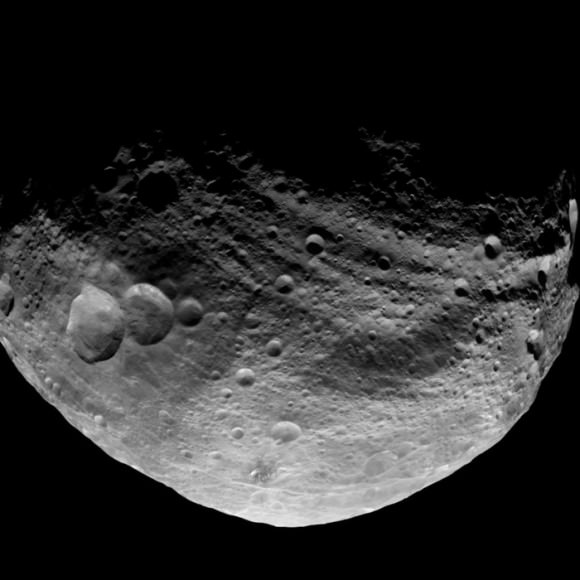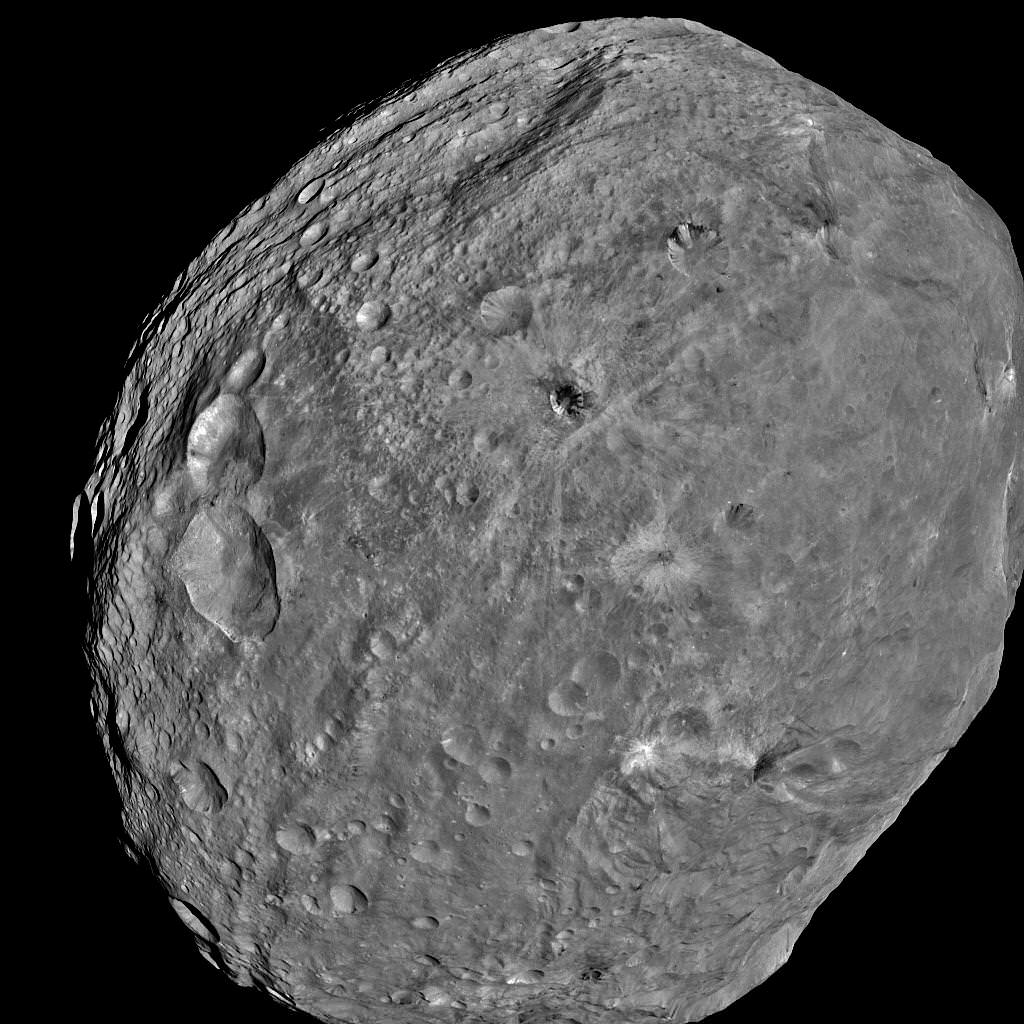[/caption]
NASA has just released the first full frame images of Vesta– and they are thrilling! The new images unveil Vesta as a real world with extraordinarily varied surface details and in crispy clear high resolution for the first time in human history.
Vesta appears totally alien and completely unique. “It is one of the last major uncharted worlds in our solar system,” says Dr. Marc Rayman, Dawn’s chief engineer and mission manager at NASA’s Jet Propulsion Laboratory in Pasadena, Calif. “Now that we are in orbit we can see that it’s a unique and fascinating place.”
“We have been calling Vesta the smallest terrestrial planet,” said Chris Russell, Dawn’s principal investigator at the UCLA. “The latest imagery provides much justification for our expectations. They show that a variety of processes were once at work on the surface of Vesta and provide extensive evidence for Vesta’s planetary aspirations.”

The newly published image (shown above) was taken at a distance of 3,200 miles (5,200 kilometers) by Dawn’s framing camera as the probe continues spiraling down to her initial science survey orbit of some 1,700 miles (2,700 km) altitude. The new images show the entire globe all the way since the giant asteroid turns on its axis once every five hours and 20 minutes.
Vesta and its new moon – Dawn – are approximately 114 million miles (184 million kilometers) distant away from Earth.
“The new observations of Vesta are an inspirational reminder of the wonders unveiled through ongoing exploration of our solar system,” said Jim Green, planetary division director at NASA Headquarters in Washington.

NASA's Dawn spacecraft obtained this image over the northern hemisphere with its framing camera on July 23, 2011. It was taken from a distance of about 3,200 miles (5,200 kilometers) away from the giant asteroid Vesta. Credit: NASA/JPL-Caltech/UCLA/MPS/DLR/IDA
Dawn was launched atop a Delta II Heavy booster rocket in September 2007, took a gravity assist as it flew past Mars and has been thrusting with exotic ion propulsion for about 70 percent of the time ever since.
Dawn will spend 1 year collecting science data in orbit around Vesta before heading off to the Dwarf Planet Ceres.
The science team has just completed their press briefing. Watch for my more detailed report upcoming soon.
And don’t forget JUNO launches on Aug 5 – It’s an exciting week for NASA Space Science and I’ll be reporting on the Jupiter orbiter’s blastoff and more – as Opportunity closes in on Spirit Point !
NASA’s groundbreaking interplanetary science is all inter connected – because Vesta and Ceres failed to form into full-fledged planets thanks to the disruptive influence of Jupiter.
Read my prior features about Dawn
Dawn Spirals Down Closer to Vesta’s South Pole Impact Basin
First Ever Vesta Vistas from Orbit – in 2D and 3D
Dawn Exceeds Wildest Expectations as First Ever Spacecraft to Orbit a Protoplanet – Vesta
Dawn Closing in on Asteroid Vesta as Views Exceed Hubble
Dawn Begins Approach to Asteroid Vesta and Snaps First Images
Revolutionary Dawn Closing in on Asteroid Vesta with Opened Eyes


Actually, it should be pointed out that the “total mass of the asteroid belt is estimated to be 3.0×1021 to 3.6×1021 kilograms, which is just 4% of the mass of the Moon. The four largest objects, Ceres, 4 Vesta, 2 Pallas, and 10 Hygiea, account for half of the belt’s total mass, with almost one-third accounted for by Ceres alone”.*
*Source: Wikipedia – Asteroid belt (Characteristics).
This is arguable, but personally I now have an open mind on that.
If the new variant of the Nice model, together with Mars dating as rapidly formed, are correct then Mars as a planet is actually one planetoid. Not the long time aggregation result of several orbit sharing planetoids as Earth is (Theia impactor; large core), and Venus and Mercury should be (large cores).
Ceres is a planetoid. Vesta is perhaps one that cooled too much to recover from the suspected large impact that marred it. If they had aggregated to a larger planetoid, we would probably happily have called it a planet analogous to Mars.
Historically that was what happened. Ceres was originally a planet. It got demoted when other largish asteroids like Vesta were discovered, in the same way Pluto were demoted when other largish Kuiper belt objects were found.
So I am falling back on the old “failed planet” description. It suits the dynamics of modified Nice models and the new criteria for planethood.
It would have been one puny planet though.
Actually, according to Wikipedia’s Asteroid belt “Origin” (Evolution) section, “[c]omputer simulations suggest that the original asteroid belt may have contained mass equivalent to the Earth. Primarily because of gravitational perturbations, most of the material was ejected from the belt within about a million years of formation, leaving behind less than 0.1% of the original mass.”
The point that I was endeavouring to convey, with my previous comment, was to quell any notions from the Richard C. Hoagland types who think that the asteroid belt is the remains of the mythical planet “Atlantis” or “Malona” that had exploded tens of thousands of years ago. Feh!
Fan-damn-tastic! Even at this resolution, zooming in shows amazing details. Fun to ponder the history behind all those bumps and bruises.
I spy – several fresh impacts.
The largish impact chain of 3 has been noted as surrounded with fresh terrain, and the smudge in the lower photo has been suspected as fresh. The new view in the upper photo has more smudges and even sets of rays around seeming impacts.
I spy – Phobos like “impact fractures”, concentric wrinkles.
I can’t tell from the photo if they surround the suspected large impact, and the Phobos’ and other such features have AFAIU never been properly established as impact/stress related. Maybe Vesta will be the data point that makes it a telltale signature.
I don’t spy – moons.
Vesta, we are so on to you now!
It does look similar to Phobos in some respects..
But Phobos is a Rubble Pile, Vesta is not.
Starting to seriously consider the south pole to not be an impart crater.
Both the North and South Poles look flat.
Could Vesta’s Shape formed that way. ?
Nice image, but the released image is hardly high resolution. (in mega pixels)
Patiently waiting…….
You may be right, there is a rotation video that looks rather like a more symmetric ellipsoid. But there are changing perspectives, so I can’t really tell.
As for the rubble pile, if an impactor hits hard enough it _makes_ a rubble pile. Or at least it could impart the same level of stresses that a looser body gets subjected to.
On the other hand, if the rubble pile is scattered and reassembled somewhere along its history there would be different regimes of mechanisms I think.
There certainly are some interesting features. The large gouge at the top left of the full frame picture with what looks like parallel ridges, the right hand side where there are less craters or they have been smoothed out and the impact 2/3 of the way down and slightly to the right which has a large amount of white ejecta for a small crater and looks almost volcanic , not to mention the fractured appearance of the landscape adjacent to that impact.